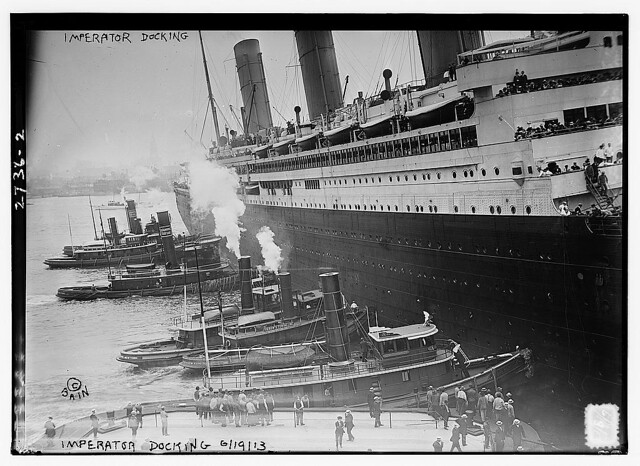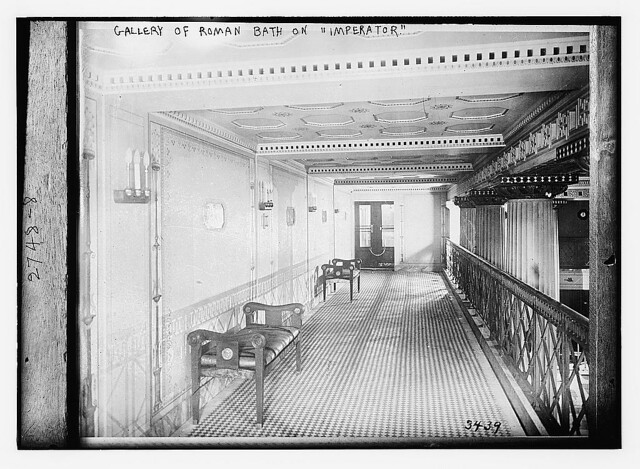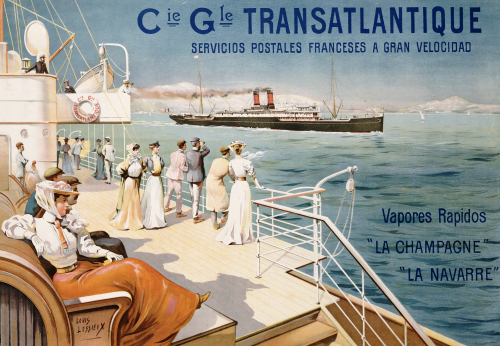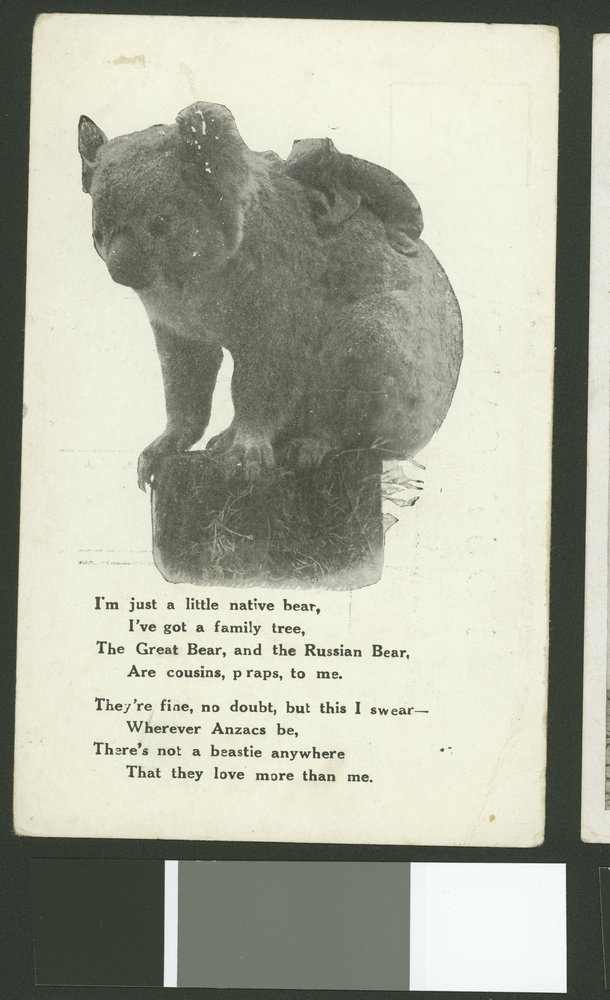When the SS Imperator made its maiden voyage in June of 1913, it was the largest passenger ship in the world. According to a gushing review in the New York Times upon the Imperator’s arrival in New York on June 19th
The Imperator, the largest ship in the world, measures 919 feet in length over all, 98 feet beam and has a gross tonnage of 50,000. Her quadruple turbines have developed 63,000 horse power which has driven her great hull through the waters of the Atlantic at an average speed of 22 1/2 knots an hour for a part of the voyage. The object of the Hamburg-American Line in building the Imperator was to give her sufficient speed to land her passengers in London or Paris on the sixth day and Hamburg and Berlin on the seventh day from New York.
The bridge is 90 feet above the water, while the three funnels extend 69 feet above the upper deck with openings 32 feet in length and 18 feet in width. Her two tapering masts measure 246 feet from keel to truck. In order to insure the safety of her passengers and crew in time of need at sea the Imperator has 83 lifeboats and two motor launches on her boat deck with special cranes to launch the boats from either side of the ship. The launches have sufficient power to tow all the lifeboats and are equipped with a wireless apparatus have a range of 200 miles.
Oh her ten decks seven are devoted to the use of the first cabin passengers and the chief feature that strikes the eye of the visitor going on board is the space that has been lavished in every direction. Looking down from the balcony into the grand dining saloon or gazing up at the lofty ceiling of the ballroom, it is difficult to imagine yourself on board a steamship. There is little of the touch of the old-fashioned steamer equipments to be found on the Imperator except the round brass ports in the staterooms and the striking of the big ship’s bell at the half hour, which is still the method of keeping time at sea.
The staircases, alleyways, decks, and saloons are remarkable for their spaciousness. The entrance hall is 95 feet wide and 69 feet long, and the three grand staircases in the main cabin are 57 feet high. On the entrance halls are situated the offices of the Chief Steward, Purser, information bureau, baggage master, surgeon’s office, with waiting room and dispensary, book store, and florist shop. Four electric elevators convey passengers from Deck G to the upper deck, and there are five freight elevators for carrying baggage and provisions.
Another feature of the Imperator which astonishes the visitor is the Roman bath, situated on deck F and deck G, which is two stories in height and carried out in marble and bronze. The bath measures 65 feet in length and 41 in widt, while the pool itself is 30 feet long, 21 feet wide, with a maximum depth of 9 feet. Directly connected with the Roman bath is a well-appointed Turkish bath, and electric bath, mineral bath, needle baths, a chiropodist, a barber, and a manicurist.
Opening from the promenade deck there is a spacious gymnasium equipped with all the latest electrically driven Zander apparatus under charge of experienced attendants. Close by the gymnasium is a large dark room for passengers who wish to develop photographic films. The ship’s printing office, where the daily newspaper is printed, is also on the promenade deck, and so are the dog kennels where passengers may leave their pet canines under the care of experienced attendants and a veterinary surgeon.
A deck–the sun deck of the Imperator, which is nine decks above the waterline, is devoted to promenading and steamer chairs. In fine weather the lifeboats are swung outboard to give additional space so that passengers have ample room to play usual deck games of shuffleboard, quoits, etc.
There is a broad companionway leading to the sun deck, as well as four elevators each with a capacity for nine persons. The smoking room on this deck is one of the largest public rooms in the ship. B deck is occupied almost entirely by the public rooms which are large and luxuriously appointed. The deck is completely surrounded by a broad promenade similar to the one on A deck. The social hall is situated well forward, lighted by broad windows extending to the deck, and sumptuously furnished, the walls being hung with Gobelin tapestry.
An attractive feature of B deck is the sun parlor and palm court. Adjoining this salon is the Ritz-Carlton restaurant, where epicures who wish to eat at their own hours and select their own dishes can have their meals served by a special staff of chefs and waiters from the Ritz-Carlton Hotel in London. In addition, on this deck there is a grill room, a veranda cafe, and private dining rooms that seat ten persons. On the Imperator there are eight kitchens equipped with the latest culinary appliances and superintended by two head chefs, assisted by 116 cooks. Altogether there are more than 500 persons employed in the serving personnel of the big liner.
The C, or promenade deck, is devoted to staterooms and the larger private suites, the finest of which, the Imperial suite, comprises twelve rooms and a veranda deck. This private deck is inclosed and serves as a sun parlor in the Winter season. The suite includes two large bedrooms with private baths, trunk rooms, breakfast room and pantry, a salon, and two servants’ rooms. The cost of this suite for a voyage across the Atlantic for two persons and three servants is $5,000.
On D, the deck below, there are a number of large staterooms with private baths, of which there are 146 in the first cabin. There are 229 regular baths and showers for general use. There are also a large number of single cabins on D deck, and each stateroom is equipped with a marble basin and running hot and cold water. The old familiar wooden berths are unknown on the Imperator, where the staterooms are equipped with comfortable brass bedsteads of artistic design. Special pains have been taken in the staterooms of the Imperator to arrange the dressing tables and mirrors at convenient height so that the light falls upon them at the proper angle.
The main dining saloon is on Deck F, and has accommodation for more than 600 at small tables to seat two, four, five, or six persons. Light is given to the saloon by windows of unusual size and an elaborate, lofty glass dome above the gallery on Deck D. First-class passengers who wish to eat their meals during the voyage in the Ritz-Carlton saloon can get a rebate of $25 from the purser for their meals in the public dining saloon. By careful manipulation, it was said yesterday, one could eat in the Ritz-Carlton for that amount during the six days. That is, by taking two meals a day and confining the menu to coffee, eggs, and bouillon, and an occasional apple or an orange. The linen used on the voyage is valued at $50,000.
Like all modern big liners, the Imperator is very steady…equipped with the Frahm anti-rolling tanks, which are built in U shape and are worked by compressed air. The Imperator has an inner hull above the waterline similar to that of the Mauretania, Lusitania, and Olympic. She has thirty-six water-tight compartments…taking her by and large, as the nautical expression goes, the latest addition to the great fleet of ocean greyhounds is a magnificent specimen of the marine engineering skill of the twentieth century.
— The New York Times, June 19, 1913









Edwardian ships certainly had everything that opened and shut for the comfort and entertainment of the guests. From what you can see of the photos, those ships had stunning dining rooms, theatres, gymnasium, music halls etc etc.
But how did the Imperator manage to allocate 7 of its 10 decks to First Class. They must have drawn on a huge number of VERY wealthy families!
As I was copying the NYT article, I started swooning over the amenities–even though I probably would have been in steerage had I lived in 1913, lol.
This was the Golden Age of ocean liner travel–and remember, steamships were the only method of travel across the Atlantic and around the world for every class of person. Plus, these lavish “ocean greyhounds” guaranteed hotel-style life on the seas.
One problem this ship had though, it was nicknamed the “Limperator” by the harbor pilots. It was bad about listing to one side. After it was given to Cunard as WWI reparations, they removed the eagle from the front and poured concrete in the double hull…only slightly helped. Imperator never quite had the appeal of the Aquitania, Olympic, or Mauretania with the public.
What a name! I did read that the ship wasn’t perfect. Quite odd considering it took three years to build!
As noted in an earlier comment the Imperator (later RMS Berangaria) had a bad reputation for rolling in even the calmest of seas. The ship was top heavy. But in most other respects she was a masterpiece of late Edwardian passenger ship design. She built on all of the novel luxuries introduced by White Star’s Olympic Class liners. including gyms, Turkish baths and a spectacular Roman styled swimming pool. She, along with her two sisters, Vaterland and Bismark, were intended to be the last word in North Atlantic ocean liners. And they were the crowning achievement of Hamburg Amerika’s master ship designer Albert Balin.
Like almost all pre-World War I ships she made the bulk of her money in the lucrative immigrant trade. Steerage passengers could be jammed into extremely tight quarters with minimal comforts and service.
There is an excellent article on her on Wikipedia which can be read here…
http://en.wikipedia.org/wiki/RMS_Berengaria
Thanks!
The opulence of these ocean liners always astound me. And today’s millionaires and billionaires think they travel well.
How did the life of “The Imperator” end?? Was it decommissioned?? Was it used in WWI?? I’d be interested to know that.
Imperator was laid up in Germany during World War I. Following the war she, along with her sisters, was handed over to the Allies as war reparations. The three great German liners were divided among the allies as follows.
Imperator went to the Cunard line as compensation for the Lusitania where she became the RMS Berengaria. Vaterland went to the US where she became the Leviathan. And the Bismark went to White Star to compensate for the Britannic and Oceanic. She became the RMS Majestic..
Remodeled to post-war British tastes the Berengaria served as the flagship for Cunard’s trans-Atlantic service in the 1920’s and early 30’s when she ran in tandem with Aquitania and Mauritania in a weekly service between New York and Southampton. But her reputation for being a delicate lady persisted and she never gained the popularity of her running mates.
Following the merger between White Star and Cunard in 1934-35 Berangaria was replaced by her slightly newer and larger sister ship Majestic as the flag for Cunard-White Star’s trans-Atlantic service. Briefly she was assigned to discount cruising, but this was a task for which she was neither designed nor suited and she proved uneconomical. With the arrival of the Queen Mary, she along with a number of other famous Cunard-White Star liners was laid up. With no interested buyers during the cash trapped depression years she was eventually sold for scrap and followed Olympic and Mauritania to the breakers in the late 30’s. Her final demolition was interrupted by the Second World War, and was only completed in 1946.
Many Thanks for the history nuggets about Imperator/Berangaria and the breakup of the German Fleet after WWI. I love reading about these events, so important at the time, but are now just passing refrences. I remember reading a book years ago about the Leviathan, which mostly centered around love affairs that took place during the voyages, but it’s a book I remember enjoying very much. Thanks again for your reply. Much appreaciated.
The Leviathan (ex-Vatherland) was another magnificent ship. Alas she had three strikes against her, mostly related to her being an American ship. First she had no running mate. America was simply not interested in building giant ocean liners in those days. So a weekly service was impossible. Secondly the ship was cursed by a reputation that European ships offered higher standards of service than American vessels. And lastly almost her entire service life was during Prohibition. That meant the ship was “dry.” Which it goes without saying did not serve as a great advertising point for the traveling public looking to go someplace where one could order an adult beverage without having to knock on a secret door and utter a password to some gangster.
There is a 1920’s travel brochure for the Leviathan which can be seen here….
http://www.gjenvick.com/HistoricalBrochures/UnitedStatesLines/1923-TheSteamshipLeviathan.html#axzz2Kvvry3Ag
As I recall, the story in the book took place, probably early thirties, when they knew their day was coming to a close. I recently looked for the book on Amazon, but it was not listed. I must have read it in the 60’s. It was just a paperback I picked up, read and remembered.